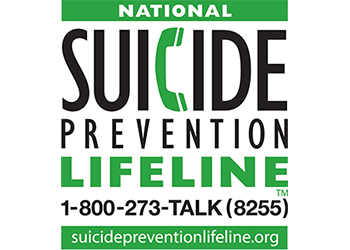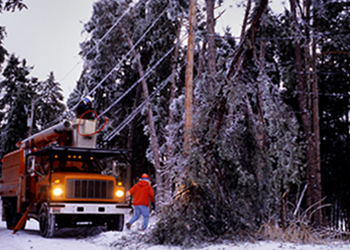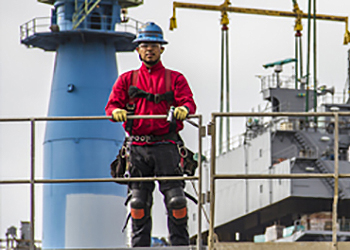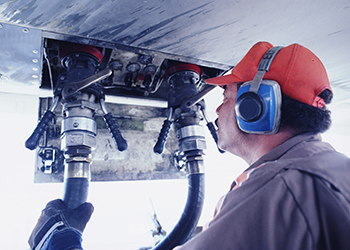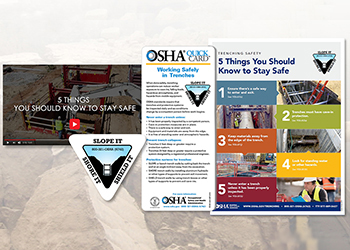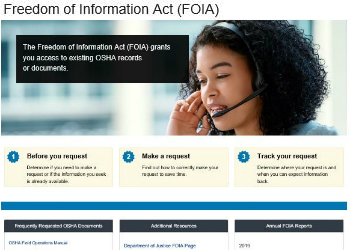 OSHA's updated webpage focuses on how to submit and track Freedom of Information Act requests.
OSHA's updated webpage focuses on how to submit and track Freedom of Information Act requests.
Monday, December 16, 2019
Working Safely in Cold Weather
During the winter season, OSHA's winter weather webpage offers tips for staying safe while working outdoors.
OSHA Crane Safety
 OSHA issued a temporary enforcement policy for crane operator certifications from Crane Institute Certification.
OSHA issued a temporary enforcement policy for crane operator certifications from Crane Institute Certification.
Keeping America's Workforce Safe
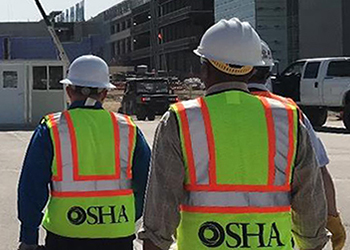 A significant increase in inspections and a record amount of compliance assistance further OSHA’s mission of ensuring that employers provide workplaces free of hazards.
A significant increase in inspections and a record amount of compliance assistance further OSHA’s mission of ensuring that employers provide workplaces free of hazards.
Monday, November 18, 2019
Holiday Workplace Safety
 OSHA has resources to help keep workers safe during the holiday shopping season as they work to get merchandise from the warehouse to your home.
OSHA has resources to help keep workers safe during the holiday shopping season as they work to get merchandise from the warehouse to your home.
OSHA Radiation Safety Hazards
 OSHA’s revised webpage provides information on how to recognize and control ionizing radiation hazards.
OSHA’s revised webpage provides information on how to recognize and control ionizing radiation hazards.
Friday, October 25, 2019
Cranes, Derricks, and Hoists in Construction
The Rutgers School of Public Health was awarded $160,000 of federal funds on September 30, 2019 through the OSHA Susan Harwood Training Grant Program to provide Cranes, Derricks, and Hoists Hazards training. 1-day Cranes, Derricks, and Hoists Training will be offered in Somerset, NJ, starting January 2020. This program is fully funded by federal funds
Northeast Industrial Hygiene Conference and Exhibition
This year’s Northeast Industrial Hygiene Conference and Exhibition will be on December 6th, 2019 at the Westin Forrestal Village in Princeton, New Jersey. Click below for the Save the Date announcement, which includes info on the topics and opportunities to sponsor and/or exhibit at the conference. 2019 NEIHce Save the Date
The NJAIHA Professional Development Courses will be held on December 5th, 2019 at the PSE&G facility in Sound Plainfield, New Jersey. 2019 PDC Save the Date.
Links to register:
OSHA requests information on Online Outreach Training
 The U.S. Department of Labor’s Occupational Safety and Health Administration (OSHA) today issued a Request for Information (RFI) to consider Online Outreach Training Program Consortiums, a new model to administer online classes for the Outreach Training Program.
The U.S. Department of Labor’s Occupational Safety and Health Administration (OSHA) today issued a Request for Information (RFI) to consider Online Outreach Training Program Consortiums, a new model to administer online classes for the Outreach Training Program.
Protecting Workers' Hearing
October is National Protect Your Hearing Month, and OSHA has resources to keep workers safe from occupational noise exposure.
Opioid Outreach
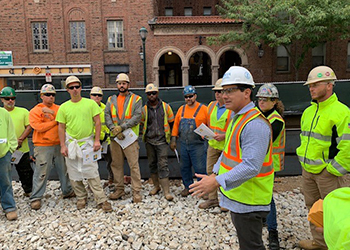 OSHA is raising awareness on how to implement a workplace program on opioids. This toolkit includes sample policies, fact sheets, presentations, safety talks, posters, white papers, reports, videos and more, so you can implement a workplace program on opioids.
OSHA is raising awareness on how to implement a workplace program on opioids. This toolkit includes sample policies, fact sheets, presentations, safety talks, posters, white papers, reports, videos and more, so you can implement a workplace program on opioids.
Understanding OSHA Inspections
 A new video explains the OSHA inspection process and how the agency is helping to protect workers from workplace hazards.
A new video explains the OSHA inspection process and how the agency is helping to protect workers from workplace hazards.
Beryllium Final Rule
The U.S. Department of Labor’s Occupational Safety and Health Administration (OSHA) has finalized its June 27, 2017, proposal to revise the construction and shipyards standards.
In the final rule, to be published on September 30, 2019, OSHA:
- Does not implement the proposal to revoke all of the standards’ ancillary provisions; but
- Extends the compliance dates for the ancillary provisions to September 2020 to account for OSHA’s new proposal to revise or remove specific provisions; and
- Maintains enforcement of the permissible exposure limit.
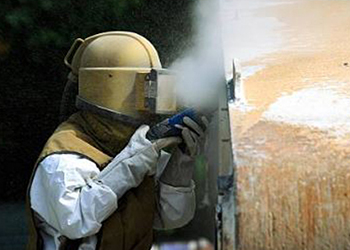
In a forthcoming rulemaking, OSHA will publish a proposal to amend the beryllium standards for construction and shipyards by more appropriately tailoring the requirements of the standards to the exposures in these industries. The proposed changes would maintain safety and health protections for workers, facilitate compliance with the standards, and increase cost savings.
Respiratory Protection Standard
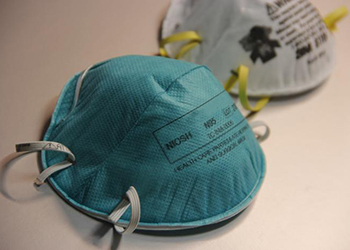 The U.S. Department of Labor’s Occupational Safety and Health Administration (OSHA) today issued a final rule that provides employers with two new fit testing protocols for ensuring that employees’ respirators fit properly.
The U.S. Department of Labor’s Occupational Safety and Health Administration (OSHA) today issued a final rule that provides employers with two new fit testing protocols for ensuring that employees’ respirators fit properly.
The new protocols are the modified ambient aerosol condensation nuclei counter (CNC) quantitative fit testing protocol for full-facepiece and half-mask elastomeric respirators, and the modified ambient aerosol CNC quantitative fit testing protocol for filtering facepiece respirators. Both protocols are variations of the original OSHA-approved ambient aerosol CNC protocol, but have fewer test exercises, shorter exercise duration, and a more streamlined sampling sequence.
These two quantitative methods add to the four existing in Appendix A of OSHA’s Respiratory Protection Standard, which contains mandatory respirator fit-testing protocols that employers must choose from to protect employees from hazardous airborne contaminants. The rule does not require employers in general industries, shipyard employment, and construction to update or replace their current fit testing methods, and does not impose additional costs.
The rule becomes effective September 26, 2019.
Monday, September 23, 2019
Opioid Toolkit for Employers
 A new employer toolkit from the National Safety Council aims to help employers create workplace safety programs focused on opioids.
A new employer toolkit from the National Safety Council aims to help employers create workplace safety programs focused on opioids.
Electrical Safety: Working safely near overhead power lines
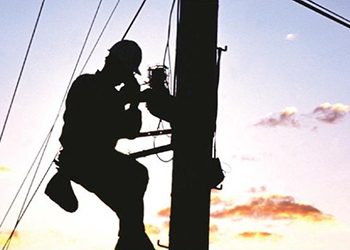 The latest in a series of OSHA Alerts offers solutions for working safely near overhead power lines.
The latest in a series of OSHA Alerts offers solutions for working safely near overhead power lines.
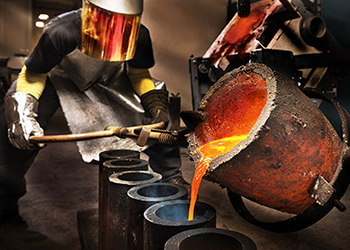 OSHA's updated webpage on heat illness explains how planning and supervision can keep workers safe from temperature extremes in indoor or outdoor environments.
OSHA's updated webpage on heat illness explains how planning and supervision can keep workers safe from temperature extremes in indoor or outdoor environments.
September is National Preparedness Month
 OSHA's Emergency Preparedness and Response webpage provides information to protect workers responding to hurricanes, wildfires, tornadoes, floods, and other natural disasters.
OSHA's Emergency Preparedness and Response webpage provides information to protect workers responding to hurricanes, wildfires, tornadoes, floods, and other natural disasters.
Celebrating Safety on Labor Day
 Labor Day honors the contributions of workers to our nation and celebrates the dignity of work. Read more.
Labor Day honors the contributions of workers to our nation and celebrates the dignity of work. Read more.Labor Day honors the contributions of workers to our nation and celebrates the dignity of work. It is a day to reflect on how workplace conditions have improved over the course of our nation’s history, and to look ahead at what we can do to continue making workers’ lives better.
Friday, August 23, 2019
Chemical Safety
 The National Institute for Occupational Safety and Health recently released a chemical management strategy that can quickly and accurately assign chemicals into categories to protect workers on the job.
The National Institute for Occupational Safety and Health recently released a chemical management strategy that can quickly and accurately assign chemicals into categories to protect workers on the job.
Trench Safety
OSHA tree care worker safety: falls and falling objects, electrocution, and other hazards.
OSHA has solutions to keep tree care workers safe from falls and falling objects, electrocution, and other hazards.
Water. Rest. Shade.
 Prepare for hot environments, whether indoors or outdoors. OSHA has resources to keep workers safe from heat.
Prepare for hot environments, whether indoors or outdoors. OSHA has resources to keep workers safe from heat. Millions of U.S. workers are exposed to heat in their workplaces. Although illness from exposure to heat is preventable, every year, thousands become sick from occupational heat exposure, and some cases are fatal. Most outdoor fatalities, 50% to 70%, occur in the first few days of working in warm or hot environments because the body needs to build a tolerance to the heat gradually over time. The process of building tolerance is called heat acclimatization. Lack of acclimatization represents a major risk factor for fatal outcomes.
Using Leading Indicators to Improve Safety and Health Outcomes
 A new OSHA webpage shows how businesses can improve safety and health programs by tracking workplace conditions and events to prevent injuries or illnesses before they occur.
A new OSHA webpage shows how businesses can improve safety and health programs by tracking workplace conditions and events to prevent injuries or illnesses before they occur.Leading indicators can play a vital role in preventing worker fatalities, injuries, and illnesses and strengthening other safety and health outcomes in the workplace. Leading indicators are proactive and preventive measures that can shed light about the effectiveness of safety and health activities and reveal potential problems in a safety and health program.
Friday, July 19, 2019
New OSHA Alert Focuses on Working Safely in Hot Weather
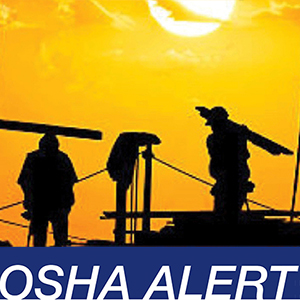 A new OSHA Alert offers information and resources to protect workers from heat-related illness when performing activities in high temperatures and humid conditions. The latest in a series of alerts addresses safety hazards and solutions that are associated with specific equipment, events, or activities.
A new OSHA Alert offers information and resources to protect workers from heat-related illness when performing activities in high temperatures and humid conditions. The latest in a series of alerts addresses safety hazards and solutions that are associated with specific equipment, events, or activities.
Hurricane Preparedness and Response
 Hurricanes and tropical storms can create a variety of hazards for workers. Preparing for weather-related emergencies plays a vital role in ensuring that employers and workers have the necessary equipment to stay safe when severe weather strikes. OSHA’s Hurricane Preparedness and Response page provides information on creating evacuation plans and supply kits and reducing hazards for hurricane response and recovery work.
Hurricanes and tropical storms can create a variety of hazards for workers. Preparing for weather-related emergencies plays a vital role in ensuring that employers and workers have the necessary equipment to stay safe when severe weather strikes. OSHA’s Hurricane Preparedness and Response page provides information on creating evacuation plans and supply kits and reducing hazards for hurricane response and recovery work.
Featured Publication: Lighting the Way for Safety and Health Programs
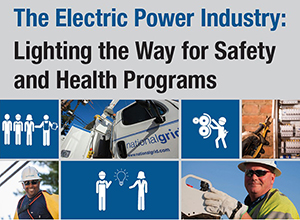 A case study produced through OSHA’s Electric Transmission and Distribution Strategic Partnership illustrates how safety and health programs can protect workers from industry hazards, such as electrocutions, falls, fires, and explosions. The study provides examples of and inspirations for programs that can find and fix hazards before they harm workers.
A case study produced through OSHA’s Electric Transmission and Distribution Strategic Partnership illustrates how safety and health programs can protect workers from industry hazards, such as electrocutions, falls, fires, and explosions. The study provides examples of and inspirations for programs that can find and fix hazards before they harm workers.
Thursday, June 27, 2019
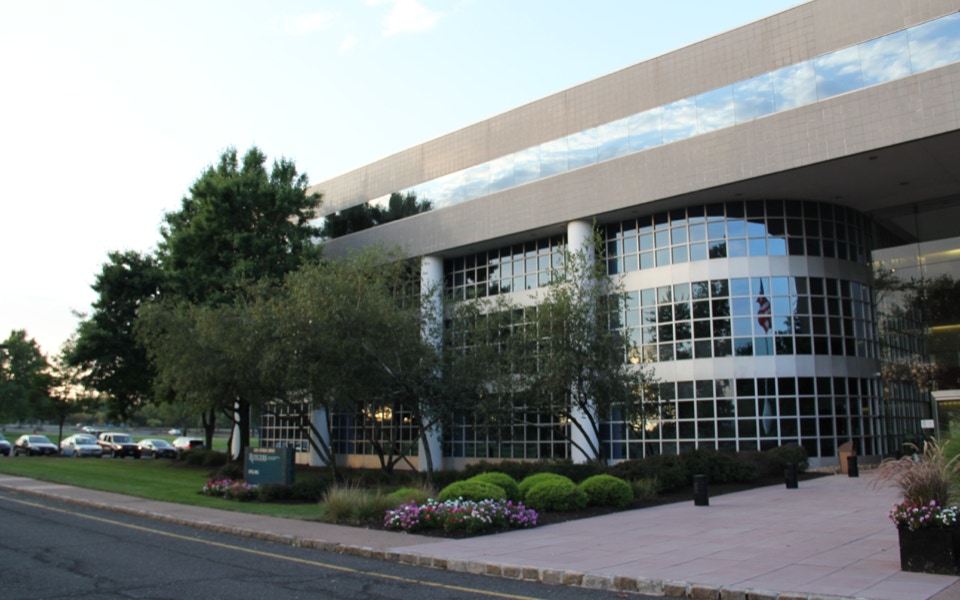 Rutgers School of Public Health is offering OSHA 7300: Understanding OSHA’s Permit-Required Confined Space Standard course in Somerset, New Jersey, in celebration of Safe & Sound week. This no fee, 1-day course will be held on August 15, 2019.
Rutgers School of Public Health is offering OSHA 7300: Understanding OSHA’s Permit-Required Confined Space Standard course in Somerset, New Jersey, in celebration of Safe & Sound week. This no fee, 1-day course will be held on August 15, 2019.Confined space entry work carries an inherent risk to workers. It has the potential to contain a hazardous environment, contain materials that have the potential to engulf an entrant, walls that converge or floors that slope downward, which may trap or asphyxiate an individual. They may also contain other recognized health or safety hazards, such as unguarded machinery, exposed live wires or heat stress.
New OSHA Resources Offer Solutions to Common Safety Hazards
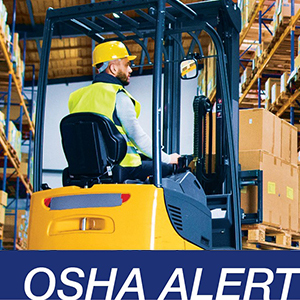 A new series of OSHA Alerts addresses safety hazards associated with specific activities, equipment, or events. Each alert identifies the hazards involved and offers clear solutions to keep workers safe. Alerts currently available focus on flood recovery and cleanup, trenching and excavation, and forklift operation.
A new series of OSHA Alerts addresses safety hazards associated with specific activities, equipment, or events. Each alert identifies the hazards involved and offers clear solutions to keep workers safe. Alerts currently available focus on flood recovery and cleanup, trenching and excavation, and forklift operation.
OSHA’s new flyer on five things you should know to stay safe in a trench addresses the most common trench-related hazards. The agency has additional resources for employers and workers on trenching safety, including a short video.
OSHA Publishes Webpage on Measles Prevention
 OSHA has a new webpage on measles, a highly-contagious, potentially serious illness with more than 1,000 confirmed cases in 28 states in 2019, according to the Centers for Disease Control and Prevention. Workers in child care and health care, laboratories, and environmental services and those who travel abroad have the greatest risk of exposure and infection. The webpage provides information about preventing and reducing workers’ measles exposure, along with information on vaccination and treatment.
OSHA has a new webpage on measles, a highly-contagious, potentially serious illness with more than 1,000 confirmed cases in 28 states in 2019, according to the Centers for Disease Control and Prevention. Workers in child care and health care, laboratories, and environmental services and those who travel abroad have the greatest risk of exposure and infection. The webpage provides information about preventing and reducing workers’ measles exposure, along with information on vaccination and treatment.
June is National Safety Month
 Each year, the National Safety Council, an OSHA Alliancepartner and key Safe + Sound Campaign organizer, designates June as National Safety Month – to highlight leading causes of preventable injuries and fatalities. Topics for 2019 are hazard recognition; slips, trips and falls; fatigue; and impairment.
Each year, the National Safety Council, an OSHA Alliancepartner and key Safe + Sound Campaign organizer, designates June as National Safety Month – to highlight leading causes of preventable injuries and fatalities. Topics for 2019 are hazard recognition; slips, trips and falls; fatigue; and impairment.
Prepare for Fireworks Safety Ahead of July 4 Festivities
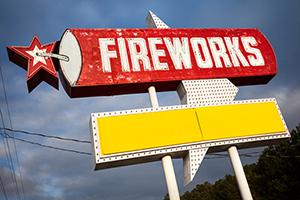 With Independence Day celebrations approaching, OSHA is encouraging the fireworks and pyrotechnics industry to begin taking steps now to protect workers from hazards while manufacturing, storing, transporting, displaying, and selling fireworks. OSHA’s website offers information on common hazards and solutions for the pyrotechnics industry.
With Independence Day celebrations approaching, OSHA is encouraging the fireworks and pyrotechnics industry to begin taking steps now to protect workers from hazards while manufacturing, storing, transporting, displaying, and selling fireworks. OSHA’s website offers information on common hazards and solutions for the pyrotechnics industry.
Safe + Sound Challenges You to Find and Fix Hazards in the Workplace
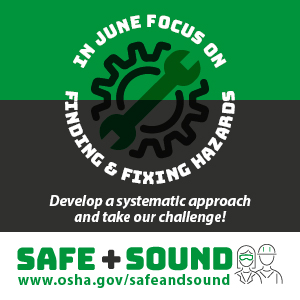 Join OSHA’s Safe + Sound campaign during June to focus on finding and fixing hazards! Effective safety and health programs should include a process for finding and fixing workplace hazards. Get started by taking our Check on Safety Challenge! Safe + Sound is a year-round campaign to encourage every workplace to have a safety and health program. Find out more on the Safe + Sound website.
Join OSHA’s Safe + Sound campaign during June to focus on finding and fixing hazards! Effective safety and health programs should include a process for finding and fixing workplace hazards. Get started by taking our Check on Safety Challenge! Safe + Sound is a year-round campaign to encourage every workplace to have a safety and health program. Find out more on the Safe + Sound website.
Keeping Workers Safe from Heat Hazards
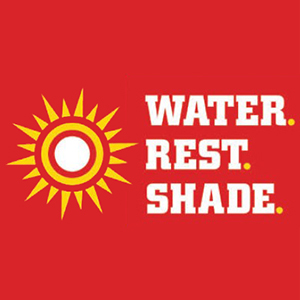 OSHA is urging employers to protect workers from heat-related illnesses and hazards. As we enter the summer season, warmer and more humid weather can increase the risk to workers both outdoors and in indoor workplaces with hot conditions. Learn how to keep workers safe by preventing heat hazards.
OSHA is urging employers to protect workers from heat-related illnesses and hazards. As we enter the summer season, warmer and more humid weather can increase the risk to workers both outdoors and in indoor workplaces with hot conditions. Learn how to keep workers safe by preventing heat hazards.
Suicide Prevention Resources
 Suicide is a serious public health concern that can have lasting harmful effects on individuals, families, workplaces, and communities. A new webpage provides confidential resources to help identify the signs and how to get help.
Suicide is a serious public health concern that can have lasting harmful effects on individuals, families, workplaces, and communities. A new webpage provides confidential resources to help identify the signs and how to get help.
Emergency Preparedness and Response
 Natural disasters can create a variety of hazards for workers. Preparing for an emergency plays a vital role in ensuring that employers and workers have the necessary equipment, know where to go, and know how to stay safe when an emergency occurs. OSHA’s Emergency Preparedness and Response pageprovides information on how to prepare and train for emergencies and the hazards to be aware of during cleanup and recovery operations.
Natural disasters can create a variety of hazards for workers. Preparing for an emergency plays a vital role in ensuring that employers and workers have the necessary equipment, know where to go, and know how to stay safe when an emergency occurs. OSHA’s Emergency Preparedness and Response pageprovides information on how to prepare and train for emergencies and the hazards to be aware of during cleanup and recovery operations.
Friday, May 24, 2019
May 31 is National Heat Awareness Day
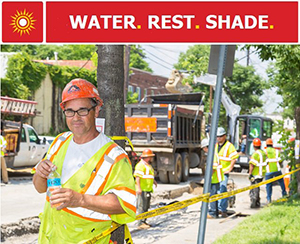 OSHA and the National Weather Service will team up on May 31 to encourage employers and workers to recognize the warning signs for heat illness and keep workers safe. Every year, there are dozens of preventable worker deaths and thousands more workers become ill from extreme heat or humid conditions. Visit OSHA’s website for information on the agency’s Heat Illness Prevention Campaign, and the National Weather Service website for heat safety tips and resources.
OSHA and the National Weather Service will team up on May 31 to encourage employers and workers to recognize the warning signs for heat illness and keep workers safe. Every year, there are dozens of preventable worker deaths and thousands more workers become ill from extreme heat or humid conditions. Visit OSHA’s website for information on the agency’s Heat Illness Prevention Campaign, and the National Weather Service website for heat safety tips and resources.
OSHA Requests Information on Possible Updates to the Lockout/Tagout Standard
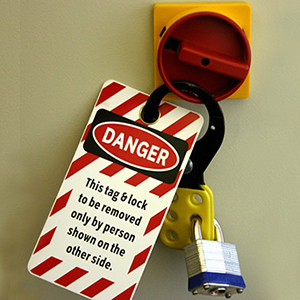 OSHA is requesting comments on a possible update to the Control of Hazardous Energy (Lockout/Tagout) standard. The agency is seeking information on how employers have been using control circuit devices and new risks of increased worker contact with robots. Comments must be submitted before August 18. Read the news release for more information.
OSHA is requesting comments on a possible update to the Control of Hazardous Energy (Lockout/Tagout) standard. The agency is seeking information on how employers have been using control circuit devices and new risks of increased worker contact with robots. Comments must be submitted before August 18. Read the news release for more information.
#MySafeSummerJob Continues Through May 17
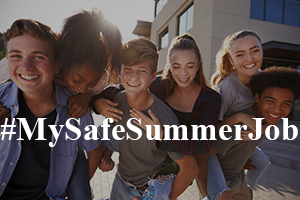 Join OSHA in raising awareness of ways to keep young workers safe at summer jobs. Slips, trips, and falls are the leading cause of injury to young workers. Most are easily preventable – some by taking simple steps to clean up spills, move clutter out of walkways, and wear proper footwear. #MySafeSummerJob includes materials for use by any organization in helping spread the word about the safety and health of young workers.
Join OSHA in raising awareness of ways to keep young workers safe at summer jobs. Slips, trips, and falls are the leading cause of injury to young workers. Most are easily preventable – some by taking simple steps to clean up spills, move clutter out of walkways, and wear proper footwear. #MySafeSummerJob includes materials for use by any organization in helping spread the word about the safety and health of young workers.
Monday, April 22, 2019
OSHA Training Institute (OTI) Education Center course offerings in Newark
 Rutgers School of Public Heath - Center for Public Health Workforce Development is offering two OSHA Training Institute (OTI) Education Center courses in October.
Rutgers School of Public Heath - Center for Public Health Workforce Development is offering two OSHA Training Institute (OTI) Education Center courses in October.
OSHA 7500: Introduction to Safety & Health Management on October 17th, and
OSHA 7505: Introduction to Accident Investigation on October 18th.
The Newark location of Rutgers School of Public Health is directly adjacent to Newark Penn Station.
The Newark location of Rutgers School of Public Health is directly adjacent to Newark Penn Station.
Featured Video: 5 Ways to Prevent Workplace Falls
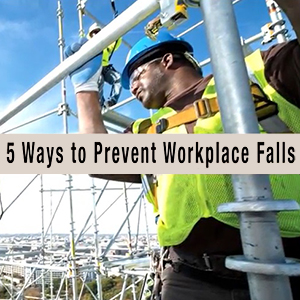 This brief video provides a quick and clear reminder that thorough planning, proper training, and well-maintained equipment are crucial to protecting workers from falls.
This brief video provides a quick and clear reminder that thorough planning, proper training, and well-maintained equipment are crucial to protecting workers from falls.
Social Media Campaign Seeks to Keep Young Workers Safe on the Job
 OSHA is partnering with worker safety organizations on #MySafeSummerJob, a social media campaign to educate young workers about their rights in the workplace, how to speak up about dangerous work conditions, and how to protect themselves on the job. Join OSHA, the U.S. Department of Labor’s Wage and Hour Division, and others over the next five weeks – April 15 through May 17 – to promote safety among young workers. Check out materials and ideas at the #MySafeSummerJob website.
OSHA is partnering with worker safety organizations on #MySafeSummerJob, a social media campaign to educate young workers about their rights in the workplace, how to speak up about dangerous work conditions, and how to protect themselves on the job. Join OSHA, the U.S. Department of Labor’s Wage and Hour Division, and others over the next five weeks – April 15 through May 17 – to promote safety among young workers. Check out materials and ideas at the #MySafeSummerJob website.
Sixth Annual National Fall Stand-Down Begins May 6
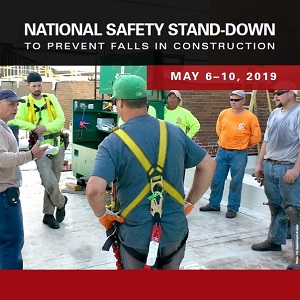 Thousands of worksites will join OSHA and its partners for the annual National Safety Stand-Down to Prevent Falls in Construction with events across the country from May 6-10. Employers and workers will pause during the workday to talk about fall hazards, OSHA compliance, and industry best practices to prevent falls in all workplaces. The lack of proper fall protection is the most frequently cited OSHA violation. Share your Stand-Down story on social media, with the hashtag: #StandDown4Safety.
Thousands of worksites will join OSHA and its partners for the annual National Safety Stand-Down to Prevent Falls in Construction with events across the country from May 6-10. Employers and workers will pause during the workday to talk about fall hazards, OSHA compliance, and industry best practices to prevent falls in all workplaces. The lack of proper fall protection is the most frequently cited OSHA violation. Share your Stand-Down story on social media, with the hashtag: #StandDown4Safety.
Controlling Respirable Silica Exposure in Construction Video
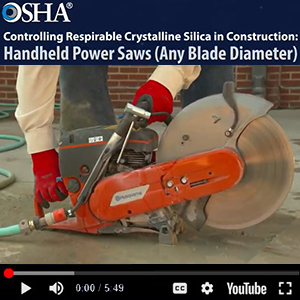 OSHA requires employers to limit workers’ exposure to respirable crystalline silica on the job. A video launched in January 2019 focuses on handheld power saws, showing how an integrated water delivery system controls silica dust created when cutting certain materials.
OSHA requires employers to limit workers’ exposure to respirable crystalline silica on the job. A video launched in January 2019 focuses on handheld power saws, showing how an integrated water delivery system controls silica dust created when cutting certain materials.
Wednesday, March 20, 2019
10% Discount on 8 Hour and 40 Hour Training Courses
 Use the following coupons codes for a 10% discount on the 40-hr Initial and 8-hr Refresher course offerings, throughout 2019. These codes may be used for any new registrations for either programs held in Somerset, New Jersey.
Use the following coupons codes for a 10% discount on the 40-hr Initial and 8-hr Refresher course offerings, throughout 2019. These codes may be used for any new registrations for either programs held in Somerset, New Jersey.For the 40-Hour Health & Safety for Hazardous Waste Site Personnel course, enter the Promotional Code: 40HR10
For the Annual Refresher on Health and Safety for Hazardous Waste Site Personnel course, enter the Promotional Code: 8HR10
Hazardous Waste Operations and Emergency Response (HAZWOPER)
40-hr Initial and 8-hr Refresher
The Rutgers School of Public Health offers the 40-hr Hazardous Waste Operation and Emergency Responder (HAZWOPER) and the 8-hr Annual Refresher multiple times during the year in Somerset, New Jersey.
Who needs the 40-hr HAZWOPER Training?
HAZWOPER training is designed to reduce the risk of chemical exposure to workers while performing site operation.
Who needs to be trained?
1. Workers who may become exposed to high concentrations of hazardous materials.
2. Workers exposed to hazardous conditions including oxygen deficient atmosphere or immediately dangerous to life and health (IDLH) levels.
3. Workers conducting hazardous waste site investigations
Topics addressed during the training:
1. Personal protective equipment for all levels of hazardous waste work.
2. Using Direct Reading Air Monitoring Instruments
3. Response protocols for emergency response and other hazardous conditions
4. Developing site controls to minimize exposure
5. Effective decontamination procedures
Who needs the 8-hr Annual HAZWOPER Refresher Training?Workers must complete an annual refresher to maintain their HAZWOPER credentials.
Rutgers School of Public Health annual Spring Open House
 The Rutgers School of Public Health annual Spring Open House is on Wednesday, April 3 from 11:00AM to 1:00PM at 683 Hoes Lane West, Piscataway, New Jersey. Please join us if you’d like to learn more about the Master’s Program in Occupational Safety and Health (OSH)
The Rutgers School of Public Health annual Spring Open House is on Wednesday, April 3 from 11:00AM to 1:00PM at 683 Hoes Lane West, Piscataway, New Jersey. Please join us if you’d like to learn more about the Master’s Program in Occupational Safety and Health (OSH)Facebook link
National Safety Council Report: Improve Safety by Reducing Workplace Fatigue
 A report from the National Safety Council reviews how employers can increase productivity and safety by reducing workplace fatigue. A single worker suffering from sleep deprivation can cost an employer thousands of dollars in lost productivity, absenteeism, and more. With 97 percent of workers reporting at least one risk factor for fatigue, most employers are affected by this issue. The report discusses the effects of fatigue on the workplace and gives employers specific, actionable guidance on implementing a fatigue risk management system.
A report from the National Safety Council reviews how employers can increase productivity and safety by reducing workplace fatigue. A single worker suffering from sleep deprivation can cost an employer thousands of dollars in lost productivity, absenteeism, and more. With 97 percent of workers reporting at least one risk factor for fatigue, most employers are affected by this issue. The report discusses the effects of fatigue on the workplace and gives employers specific, actionable guidance on implementing a fatigue risk management system.
Guidance: Limit Heavy Lifting During and Immediately After Pregnancy
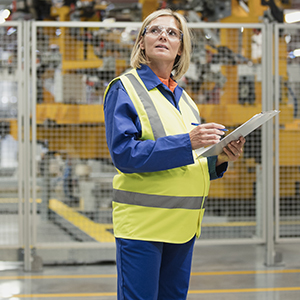 Workers can safely perform manual handling tasks during most of their pregnancy, but they need to consult with their doctors to set appropriate weight limits. The American College of Obstetricians and Gynecologists has guidance on appropriate limitations throughout pregnancy and immediately after giving birth. The National Institute for Occupational Safety and Health has additional resources on pregnancy and the workplace including an infographic on provisional weight limits for lifting on the job.
Workers can safely perform manual handling tasks during most of their pregnancy, but they need to consult with their doctors to set appropriate weight limits. The American College of Obstetricians and Gynecologists has guidance on appropriate limitations throughout pregnancy and immediately after giving birth. The National Institute for Occupational Safety and Health has additional resources on pregnancy and the workplace including an infographic on provisional weight limits for lifting on the job.
Revised Webpages Address Safety in the Agriculture and Maritime Industries
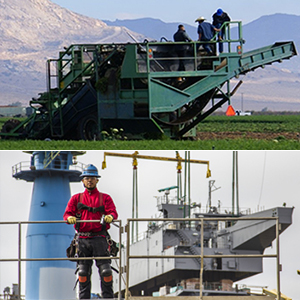 OSHA’s revised Agricultural Operations webpage makes it easier for users to find safety information on agriculture-related hazards, such as grain bins and silos, heat, machinery, pesticides, and other chemicals. The revised Maritime Industry webpage offers compliance materials, training information, and other resources to eliminate hazards in longshoring and marine terminals, commercial fishing, and shipyards
OSHA’s revised Agricultural Operations webpage makes it easier for users to find safety information on agriculture-related hazards, such as grain bins and silos, heat, machinery, pesticides, and other chemicals. The revised Maritime Industry webpage offers compliance materials, training information, and other resources to eliminate hazards in longshoring and marine terminals, commercial fishing, and shipyards
Subscribe to:
Comments (Atom)


